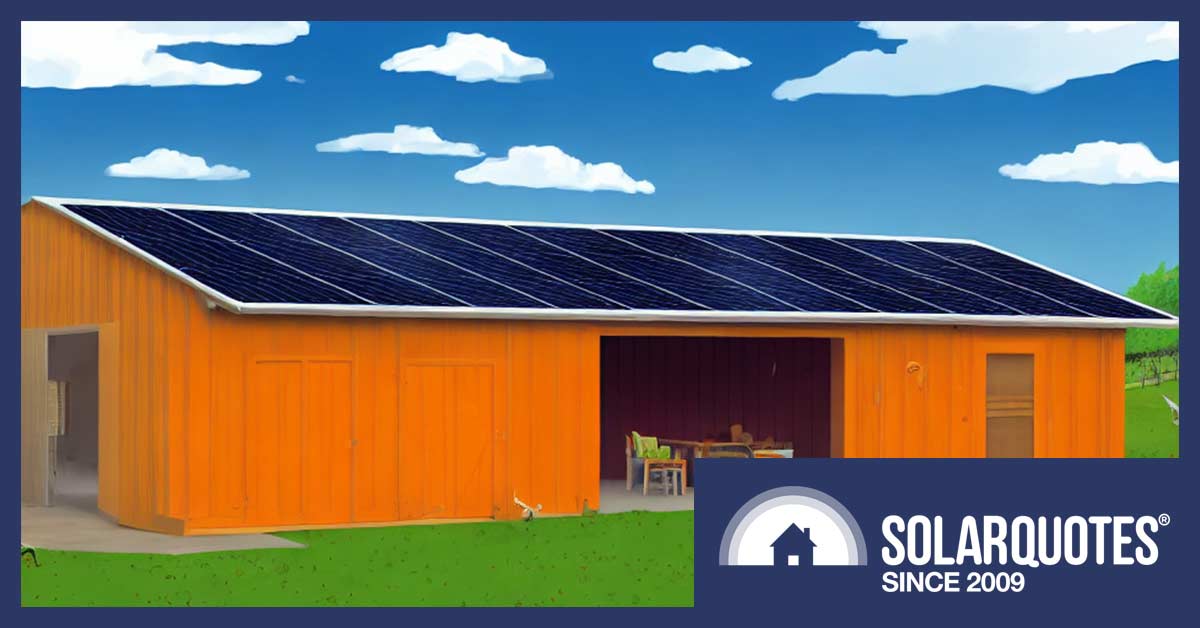
Image: StarryAI “Big Shed With Solar Panels”
Top tips for installing solar on your man-cave. Or lady-lair.
So there’s a shed at your place that seems ideal for solar panels, but it’s well down the back of the block. Can you install solar panels on it, and if so, how much?
The short answer is: it depends on how thick you are prepared to go with the cables from the shed to the switchboard. The cable thickness required varies wildly depending on how much power you want to move over what distance. It’s Ohm’s law.
To start with, your DNSP1 will have an SIR2 book with rules about the SPD, MPD, meter isolator3, service size and meter location. But perhaps we should back up a little …
The Water/Electricity Analogy.
Voltage in Volts = pressure trying to burst out of the pipes.
Current in Amperes (amps) = the volume of water flow.
Resistance in Ohms = the drag or impedance that causes low flow and high pressure.
5% Voltage Drop Allowed In Your Home
Electrical rules (AS3000) say that from:
- the “point of supply” on your premises (which might be the fuse on the eave or the retail meter box)
to
- the farthest power point or light,
there can’t be more than 5% resistive loss at full load4.
For solar power systems, the rules are more stringent. Australian Standard AS4777.1 stipulates a maximum 2% voltage drop, (or voltage rise depending your perspective) from the solar inverter to the ‘point-of-supply’ (where your house connects to the grid). Some houses need the same fat cable that connects you to the street, just to connect the inverter. It’s a bit like having a fire hose to make perfectly sure your garden sprinkler covers the lawn properly.
The quality of grid electricity is the reason. By law, the pressure supplied to you isn’t 240 volts, it’s actually a nominal 230 volts, and it’s allowed to drop 6% or rise 10%. I’ll be honest here; I’ve seldom measured it below 240 anyway.
In the same vein, you’re not allowed to supply electricity back to the grid under 216 or over 253 volts. But the catch is, if you’re going to export energy, your inverter must push the solar electricity out at a higher voltage than the grid. You need to generate the pressure that pumps energy back into the street.
Here begins the conundrum. As more solar capacity is added to the network, all those inverters push up the voltage in the street, and the DNSPs have to do more things to keep the voltage down. Sometimes we have to call the power company and lodge a complaint if they’re not keeping it under control.
At the bleeding edge, SA Power Networks have taken to turning down (or turning off) solar power systems remotely if things begin to go pear-shaped using ‘world-first’ tools: substation-level voltage management and dynamic export limits. It’s pretty interesting – grid stability is now partly dependent on a lot of dodgy customer-owned WiFi connections, but it seems to be working.
If you have solar panels and their inverter on a distant shed, the problem is compounded for you because in order to make the energy flow from your inverter back to your house, the voltage needs to rise even more. You can end up with 253 volts at the inverter, but because of drag, (think of a kinked garden hose), even at 253 volts there’s still not enough pressure to reach the house and efficiently use your own energy, let alone export to the grid.
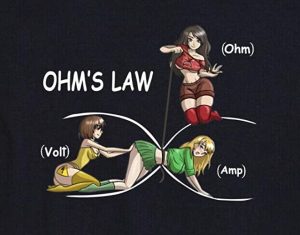
Ohm’s law has been updated for the internet age but remains fundamentally the same concept.
Don’t worry, you won’t risk blowing things up with ever-increasing voltages. The inverter will derate itself by 5% for every volt above 253, and it’ll cut out completely at 258 volts after ten minutes.
These problems get worse still on rural SWER connections. Under the old standards, solar would rise to 263 volts and still be running at full output. This excess voltage creates waste heat in your appliances and I can assure you, having lived with it, 263 volts will incinerate your toast.
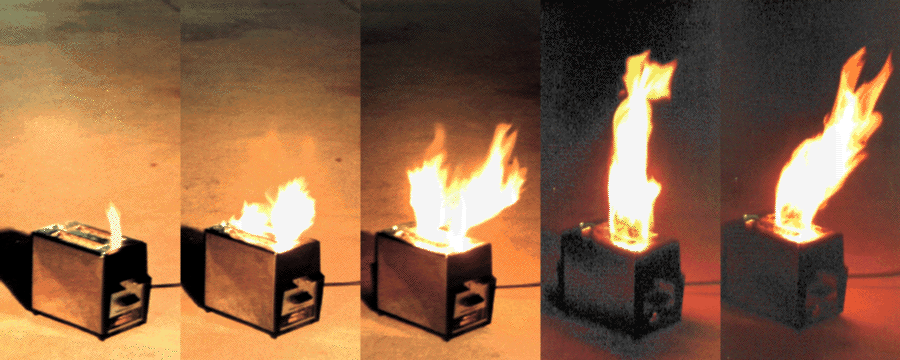
Image credit: http://www.pmichaud.com/toast/
What Wire Size/Thickness Will We Need?
It depends. Naughty electricians won’t bother with the proper calculations. Rules of thumb and assumptions abound, so it’s worth quizzing them for both your sake and theirs. It saves the embarrassment of your solar inverter tripping off because its increased electrical pressure climbs too high to overcome the drag on the way to the main switchboard
As a guide, the typical garden shed might have a 2.5mm2, 16amp feed shared from the house somewhere. For a workshop, the rule of thumb is a 6mm2 cable and 32 amp breaker in the house… the one that Mum switched on and off to get you to come up for tea, back when mobile phones weren’t a thing.
Coincidentally, that nominal 32 amp capacity is just what an average 7.5 kW EV charger calls for. That means when you get an EV, if you put your Level 2 EV charger in the shed, you won’t have enough flow to do more work there – not even to run the beer fridge.
Big Loads In The Shed Can Reduce Your Solar Losses
Say you’ve got a 6mm2 cable to the shed, and it will cost a motza to upgrade it. You were hoping to put 6 kW of inverter and solar panels on the shed roof to help charge your EV.
Some installers may say you can only install a 3kW solar system to stay under a 2% loss in that cable. The pressure will be high when there’s lots of sunshine, because drag from an undersized cable will choke off the flow from your 6kW solar system.
The more enlightened installer may offer you the full 6 kW, knowing an EV on a level 2 charger can soak up all the power those panels produce, until it’s fully charged and a 3kW export limit brings things under control.
It’s a great example. The saving grace for solar is that it isn’t so much an extra load on the network, it’s actually unload5.
What’s The Proper Solution For Solar Cable Thickness?
First, we measure, then calculate. It’s distance versus load, with adjustments for cable type, installation method and temperature de-rating.
To go longer distances, you increase the cable size. Jumping from 6 to 10 to 16mm2 (or even more) costs a few bucks in copper, but will likely cost a lot of bucks in conduit and a new trench. However, that presents an opportunity. I always insist we put some data cables in (because you’ll need them later anyway) and I have even seen a pipe to the hot water service added for a little shed luxury. The wisest of all customers will bury a 90mm stormwater pipe to use as a duct to pull other services through later.
Now that solar systems are getting much bigger, network operators are insisting on export limits. To achieve technical compliance, an inverter smart meter 6 is installed at your main switchboard so your solar power system can see what’s coming and going.
A trap that befalls some is this smart meter must have an RS485 communication link to the inverter. There are some wireless solutions available, but a hard-wired connection is always best; so it’s handy you’ve already installed a few extra data cables while you had a trench open for the new shed supply.
And The Upshot Is?
There are lots of reasons to install solar panels on your shed:
- It’s often much easier to install more solar onto a straightforward shed instead of a quintuple-fronted tile-roofed house.
- Many people prefer solar out of sight.
- Often your outbuildings have a different aspect or better sun access without tree shade.
- It’s valuable extra space for those who love big solar systems.
So, if you have the option, and you can get good connectivity for electricity and data then sheds are a great place for solar panels. Especially when I don’t have to climb through this nightmare:
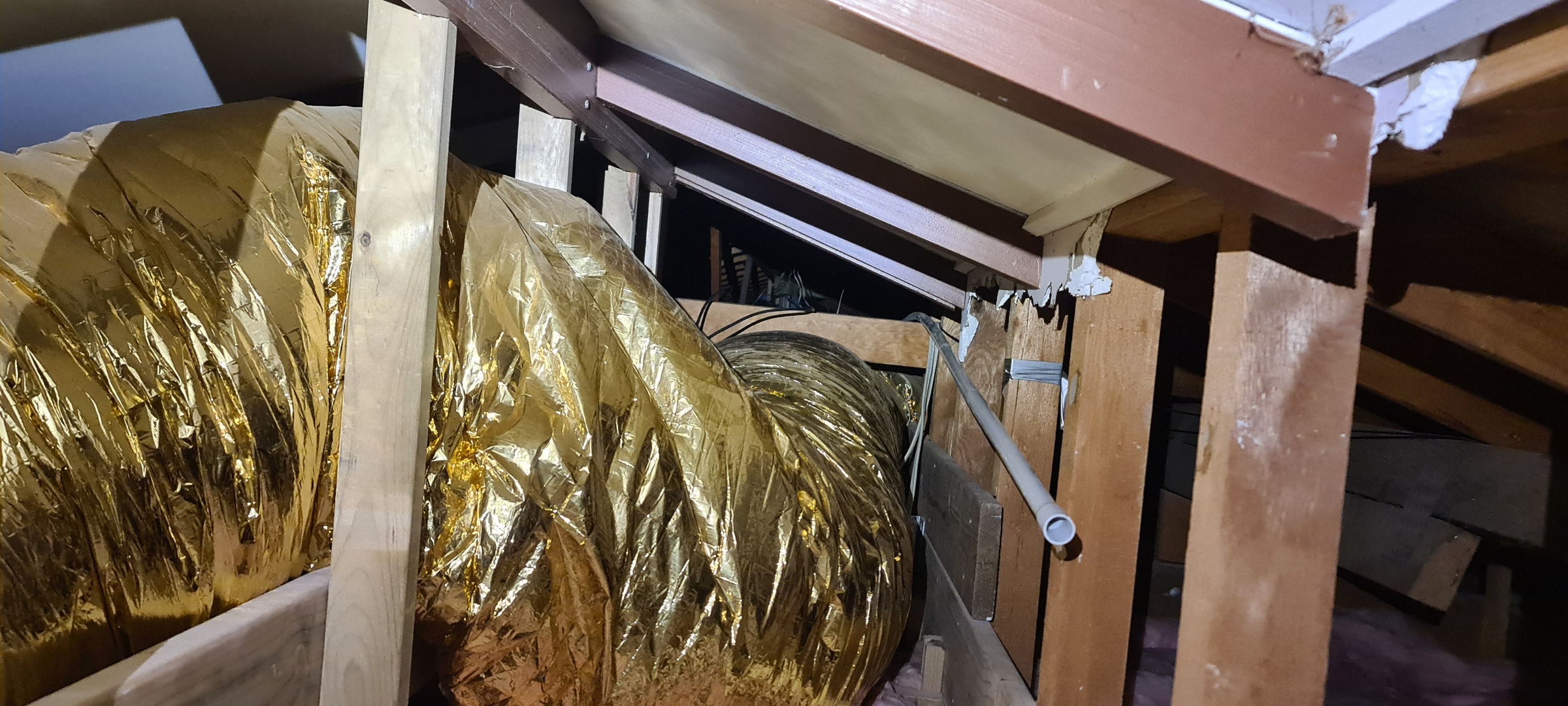
Yes, I crawled through there because the apprentice is too young, tall and handsome to fit.
A Better Alternative: Long DC Cables
Covering the distance with high voltage DC is the answer if you have the right solar design. It will still involve a trench or overhead conduit but potentially less copper and more efficiency, which makes a large system feasible where it would otherwise just be too far away.
You see, the magic of electricity is high voltage and low current will do the same amount of work as low voltage and high current. The AC side of your system is limited to 250ish volts, but the DC side is legal up to 600 volts. Sadly, conflicting Australian standards prevent us from using 1000 volts; which everything is designed for internationally.
So, for example, for 3 kW of power pushed through a 6mm2 copper cable:
- 240 V AC and 12 A, standard AC cable at 75ºC = 27m with 1% loss
- 600 V DC and 5 A, in better quality DC cable rated for 90ºC = 152m with 1% loss
In the first example, you could have a shed around 10 metres from your switchboard. However, in the second example, the difference is dramatic: higher voltage means your outbuilding can be 75 metres away.
There you have it. Solar power really can go the distance when you get the design right.
Footnotes
- Distribution Network Service Provider… the poles and wires people in your area. ↩
- Service and Installation Rules… the book they publish explaining what you have to do when connecting to the grid. ↩
- Service Protection Device – Meter Protection Device – Meter Isolator… The fuse that blows when your local indoor gardener has too many lights on their tomato crop. ↩
- Of course, there’s an app for that. ↩
- Something we have had to teach the old DNSP officers in the past, they couldn’t imagine flow in both directions ↩
- I wish the smart person who came up with this smart meter terminology hadn’t applied it to every retail revenue device, inverter measuring equipment, consumption monitor and load diverter. ↩


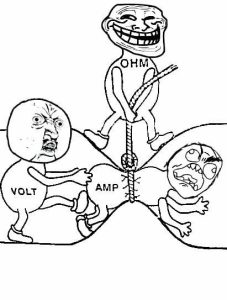
 RSS - Posts
RSS - Posts



An interesting article. I confronted this when building my shed, flat and house on a very long 6000sq m urban block. My meter is 78m up the driveway from the distribution pit. My large shed, where I wanted the solar and inverter plus general power and comms is 50m further up the block. I then have a flat just across from the meter box (about 20m to the outside wall, another 5m to the internal board). The house is about 45m up on the shed line then another 20m across to the wall, and 2 internal boards at each end spaced 8m and 20m from the wall.
My sparky who like me is an old car nut and does does restoration work in his shed too suggested I run 3 phase power throughout, from the front pit to the internal distibution boards. His point was this would minimise the voltage drop but the cost of standard size cable in extra long bulk lengths was about the same as that of the much larger cable required on single phase. Plus I would have the flexibility of running higher draws in the shed for welding etc at only slightly increase costs for breakers etc.
I also run a 7.1kq 3 phase Fronius inverter and 9.2kw of quality panels and it all seems to work very well with good voltage being def in at the meter.
I am not technically qualified but from fiddling with the power system, batteries and charging processes in my offroad camper I was aware of the issues related to voltage drop.
Might be worth considering for others?
DC side is legal up to 600 Volts but please be aware that this is a VERY lethal voltage and also be aware that a DC arc at anything above 50 Volts is very impressive.
At 100 Volts?
One flash and you’re ash 🙁
Tell me you only recommend micro inverters without telling me you only recommend micro inverters.
Could just make the shed an off-grid site. Use any existing grid AC supply as a supplemental source of energy. Perfect for an all-in-one off-grid inverter.
My shed had a sub-switchboard, which was upgraded, and the AC cable link got upgraded when I installed solar on the shed. Took an extra day of work to run the cable, dig, wire in etc, but on the flip side, the shed is now ready for a EV charger.
I’d prefer to run something other than ‘stormwater pipe’ for any service other than for stormwater run-off. The wall thickness of stormwater pipe is the thinnest of all underground PVC pipes. DWV is thicker, but again that’s for drain, waste and vent plumbing.
I’d recommend going with a heavy duty electrical conduit for anything electrical or data related if your wires are not rated for direct burial. Even for ‘future proofing’ I’d be putting this in rather than stormwater pipe just in case your future is electrical.
And if you are running water supply lines, they make pipes specifically for that purpose that you can bury, just ask your plumber.
Declan:
Property owners, with a bit more land than their city cousins, are in a great position to install a second Solar PV + Battery Storage Off Grid Solution on their property in addition to an already existing On Grid System.
Importantly the second Off Grid Solution is entitled to STC’s and the System size can be quite large. The CER rule is that the second system plus the first system [if any] must in total be no greater than 100 kW. So if you have a 10 kW On Grid System for example, you could install a 90 kW Off Grid Solution for a total of 100 kW of Solar PV Systems and receive the full quota of STC,s applicable to the location, for that 90 kW Off Grid Solution.
The optimum systems functionality, including load circuits switching and control between the Grid Supply Source and the Off Grid Supply Source, will require the services of an Off Grid Solutions Integrator specialist experienced in these designs.
A second important point: The author Anthony Bennett has highlighted the most important topic of higher voltage RE systems. Unfortunately there are very few Australian RE Engineers / Electricians that are qualified, and/or experienced in higher voltage DC storage stacks/systems design and installation. This is the main stumbling block holding back the Australian RE Technology Sector from Innovating and moving forward, with worlds best practice Solar / Battery / Ultra Capacitor / Power Plant Solutions design.
Starting my engineering career in 1965, I worked almost exclusively for many years on 400+ VDC equipment; large scale DC power generators; and high voltage accumulators [battery stacks]. The benefits of training, experience and qualifications in this sector had profound benefits when the RE / Solar PV Industry started to gather momentum in the 1990’s.
Ohms Law teaches us that the higher the VDC the lower the current; smaller CB’s, higher efficiency, and a ratio-metric reduction in the kg’s of copper required for the energy system.
Lawrence Coomber
I have a full functional magnet motor that actually produces usable torque and RPM. Can easily drive a generator. A box about the size of a mini fridge can power an average size house
John:
What power source drives the motor that drives the next power source generator in your design suggestion?
What practical electrical engineering logic underpins your overall [daisy chain] design John?
Lawrence Coomber